Today, I want to take you on a little exploratory excursion into the art and illustration behind a famous collection of embroidered panels. Being rather the curious sort, I tend to fall into little rabbit holes when I start exploring, and sometimes, the results can be rather serendipitous!
In 2015 and 2016, the Royal School of Needlework (RSN) made their collection of ecclesiastical embroideries available to public view through the exhibit For Worship and Glory.
If you were fortunate enough to see the exhibit in person, lucky you! For those of us who weren’t, the catalog of the exhibit is still available here through the Royal School of Needlework.
It’s a beautiful catalog, and worth adding to your collection if you are keen on ecclesiastical or historical embroidery. It covers many items in the exhibit, besides the Loreto embroideries.
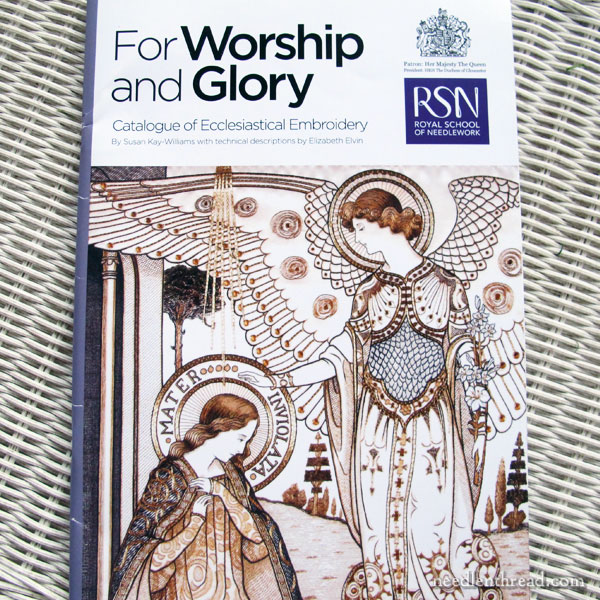
The Loreto embroideries held by the RSN have always enchanted me. I’ve mentioned them several times here on Needle ‘n Thread, and I’ve collected pretty much every printed bit from the RSN about them.
Over the years, the RSN offered different printed images of the Loreto embroideries – from postcards to greeting cards, a booklet, and lately, this exhibition catalog, which I think shows off the embroideries beautifully.
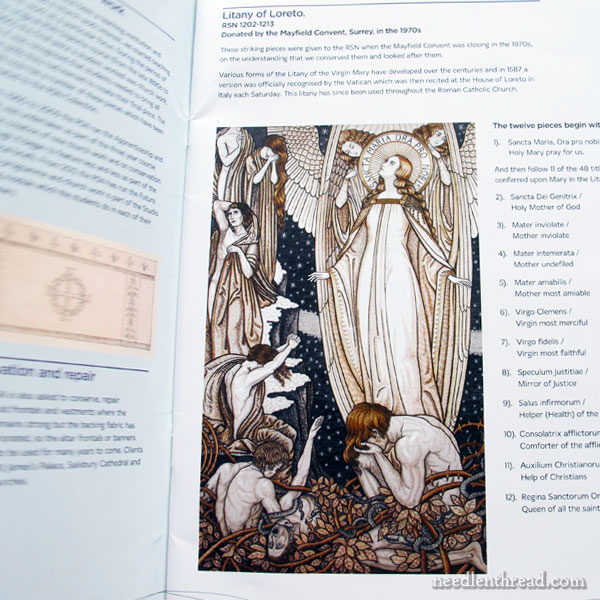
Since little seems to be known about the Loreto embroideries and who designed and executed them, I’ve always kept my eye out for similar works, hoping to find the artist connection. Someone had to draw them, after all.
The RSN acquired 12 panels altogether from the Mayfield Convent in Surrey, when it closed in the 1970’s. The catalog states:
As embroideries these are remarkable pieces. Obviously designed, but we do not know by whom, worked to a high standard probably by the nuns. They also show what can be achieved with a limited colour palette and a remarkably limited stitch selection. We believe them to be 20th century works, despite the “pre-Raphaelite” hair.
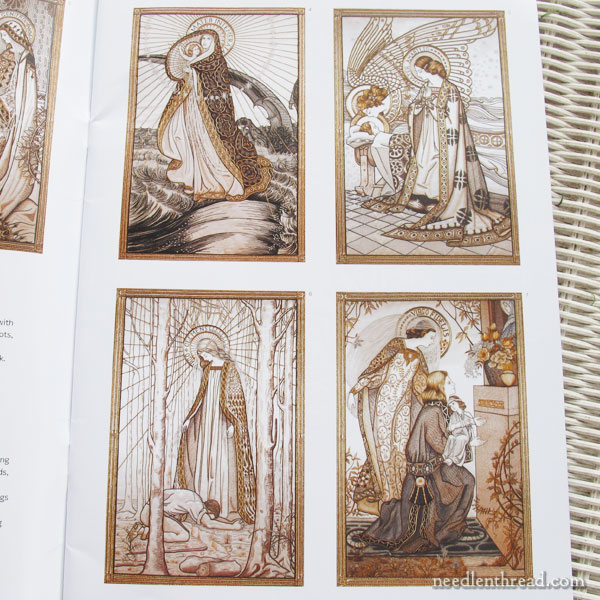
The Divine Comedy & a Rabbit Hole
My “infatuation” with Dante and the Divine Comedy began when I was in college, and almost-30-something years later, I still love to read Dante when the mood strikes. I’m a bit of a collector of Divine Comedy-related stuff, from editions, to art, to even … yes… Dante and Beatrice book ends. What can I say?
So it wasn’t unusual that, one day, I was exploring online, looking for illustrations of the Divine Comedy.
Familiar with Gustave Doré’s ubiquitous illustrations, I was looking for something different and a little less common.
In my explorations, I came across the Divine Comedy illustrations by Italian artist Tiburzio Ezio Anichini (1886 – 1948). Initially, these were actually postcards commemorating the 600th anniversary in 1921 of Dante’s death.
From there, I fell down a rabbit hole, exploring Anichini’s illustrations and artwork.
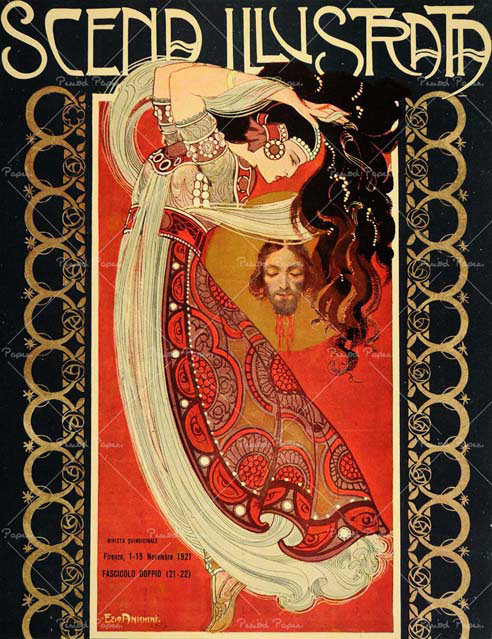
Ezio Anichini was born in Florence in 1886. He was the son of artist Giuseppe Anichini (1862 – 1936), and better known than his father, thanks to his profuse cover illustrations for Scena Illustrata, a popular Italian magazine based in Florence, and for many other popular magazines at the time. He was also a book illustrator.
Anichini was an Art Nouveau artist – or at least, his work belongs to that stylistic era.
The Art Nouveau movement revolved around a rather short-lived artistic style that embraced art, architecture, textiles, and design. The style was popular from about 1890-1910, springing initially from the Arts and Crafts movement of the second half the 1800’s in Britain, of which William Morris was a big player.
As the Art Nouveau movement spread around Europe, each country contributed its own twist and interpretation, as is always the case. In Italy, Stile Liberty – apparently called so due to the influence of the designs of Liberty of London – lasted perhaps a little longer than the Art Nouveau movement, which was pretty much going out of style by 1910, to be replaced with Art Deco.
Anichini is the Illustrator behind the Loreto Embroideries
In any case, that’s the era Ezio Anichini was artsying about in, and that is the era that certainly influenced his Loreto drawings.
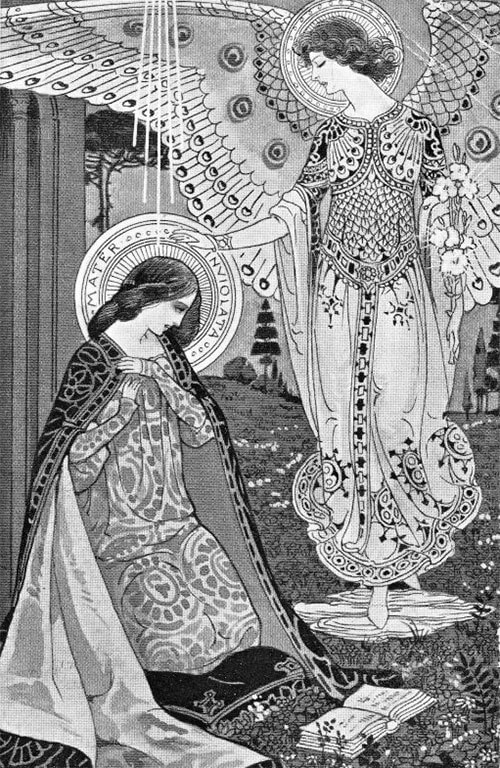
Between approximately the years 1915 – 1920, Anichini produced 46 postcards depicting the titles of the Blessed Virgin in the Litany of Loreto.
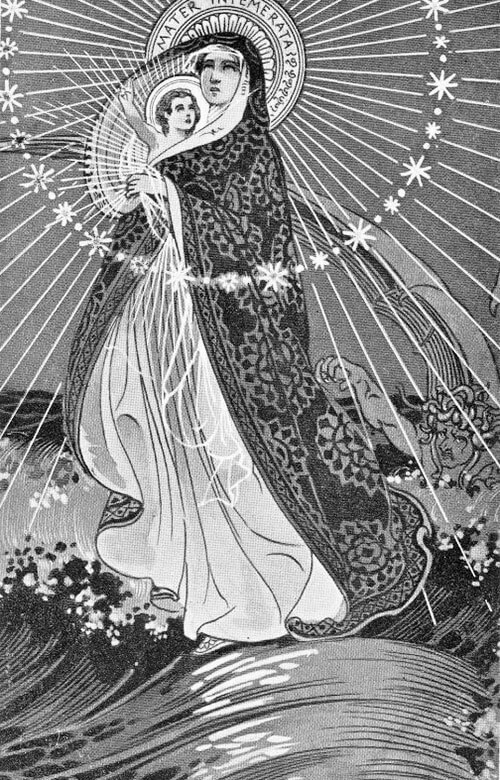
He is definitely the illustrator behind the Litany of Loreto embroideries held by the RSN.
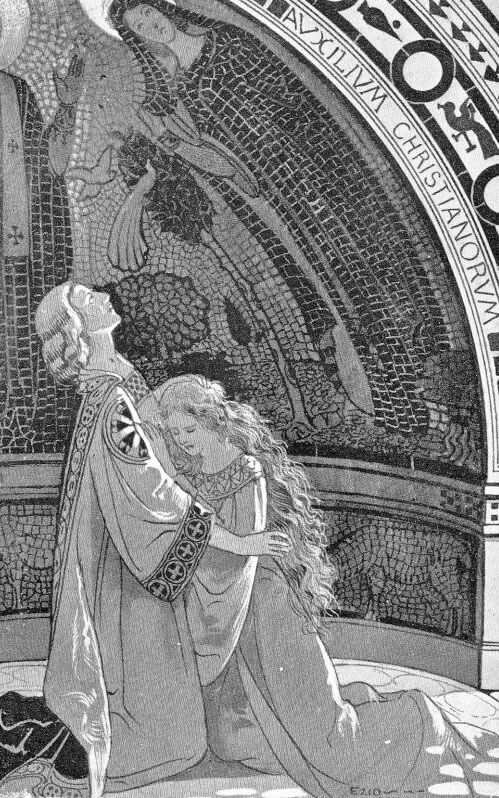
If you compare the embroideries above to the illustrations, I don’t think there can be much doubt that he was the original illustrator. Whether or not the embroideries were worked with his knowledge or his participation in the drawings and any variations in them – who knows?
Perhaps the embroideries were simply the adventurous undertaking of someone inspired by the postcards. Certainly the original embroiderers would have had a copy of the drawings in some form.
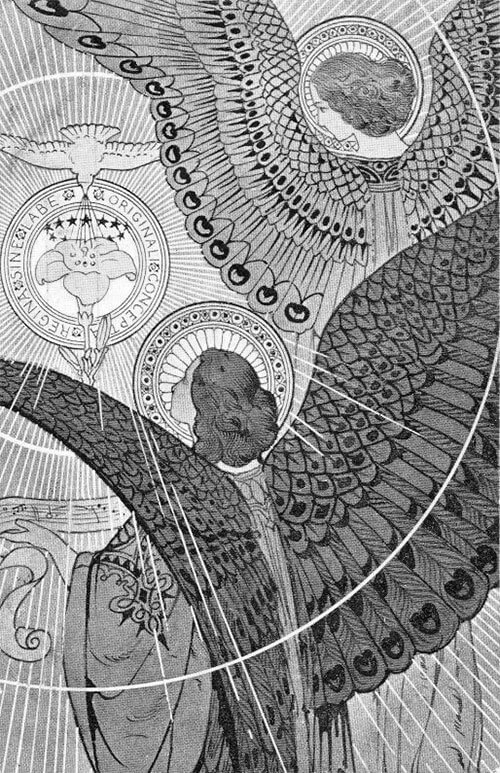
Besides the twelve images that are the basis of the Loreto embroideries held by the RSN, there are 36 other images in the same style by Anichini depicting the further titles of the Virgin in the Litany of Loreto.
It was a happy discovery, finding the artist whose work inspired the beautiful Loreto embroideries.
This is the type of rabbit hole I’m happy to fall into, any day!







Yes, what a wonderful rabbit hole! I will be following you down it. 🙂 I love Dante and the Divine Comedy too and have just started the Paradiso. That is a book that came be read over and over.
Amazing!
Mary,
Congratulations to you for finding the mysterious artistic source for the lovely Loretto embroideries. I know you must be thrilled. Anichini’s works are really quite beautiful. Are you going to tackle one of them as an embroidery project? You should. You’re more than up to it 🙂
About 15 years ago I was looking through some wonderful sketches in an embroidery collection for a mirror surround with a nursery rhyme theme. I loved the surround and still hope to stitch it someday. I thought that the sketches for the surround were original. However, a few years ago I stumbled across a long out of print book of nursery rhymes at the University that held almost all of the drawings. I was so surprised and delighted. I can only imagine how happy you must have been have run down this rabbit hole and make the connection between the Loretto embroideries and Anichini! Bravo!
Margaret, the nursery rhyme book sounds interesting. Can you share the bibliographic information about it?
Have you contacted the RSN? I think this is fascinating! Aren’t rabbit holes wonderful? Keep up your curious thinking, it is fabulous!
You definitely should inform the RSN if you haven’t done so already. Let us know what they say about your research. I think it is fascinating!
Wow, Mary, what a fantastic piece of research! I’ve always been captivated by the pieces and was lucky enough to see them up close many times.
Mary, I am delighted to learn you also like Dante. I am very curious to know which is your favorite translation? I have several including Longfellow, Mandelbaum, Dorothy Sayers, and Clive James. People like to laugh at it but I enjoy Dorothy Sayers attempt to mimic terza rima. Some of my friends prefer Pinsky which I have not yet read. Do you read it in the original Italian? Thanks for a delightful blog today.
These are beautiful! Jumping down the RH now. I’ll be back in the spring
Mary…Wow, is your middle name “Agatha Christie”? Why…because, like her, you just solved a mystery! This is incredible! Congrats!
Well done Mary! I was fortunate enough to see the exhibition and spent hours, in a freezing cold Ely cathedral, gazing at these and other beautiful embroideries. Have you let the RSN know about this?
Fascinating. Thank you. I remember writing to you after I had seen the exhibition of this exquisite work which the RSN are very blessed to have had the task of preserving and exhibiting. I do believe that their publication of so much in the way of books and cards and various financial outlets more than rewards them for their task.
I hope they make them available to view very often, to observe and take in the stitching and the truly spiritual love that made them is inspiring.
Your ‘detective’ work, is really valued, because there certainly was not this detail in the exhibition. I am sure the RSN will be delighted! Best wishes Margaret.
Very well done, Mary! This article is right up my alley and I am thrilled to see the fruit of your rabbit hole. I love to discover these types of connections. Especially related to different art forms. Very interesting topic. Thank you for sharing!
Well done Mary! Fascinating. I’m sure your research on this topic is worthy of publication as a larger article in an appropriate journal – Inspirations at least!
Interesting research, Mary! I concur with the others that you should share with the RSN, in case they haven’t made the connection.
I’ve never read Dante, but now am intrigued…
I would love to know if you informed the RSN of your discovery.
Yes, I heard from them this morning. They are apparently also researching Anichini. Should be interesting to see what they come up with!
Well done, Mary!
Fascinating! That’s for the trip down the rabbit hole! (“drink me!”) This is a style that I love. I have never “noticed” it in ecclesiastical works, and I look forward to looking into this artist’s works. Fun!
Brava!! Well done!
Mary, this is fantastic! Congratulations on a wonderful discovery. Amazing!
I have to know if RSN has responded.
Would this collection of Anichini have been available in England?
This may lead closer to the embroiderer. Thank you
Wow! As an art history grad I love everything about this. I love the beautiful style of art nouveau. Your site is such a gem and I always look forward to your posts. Thanks for sharing this!
Very cool! I was lucky enough to see the exhibition and the Loreto pieces were the star of the show for me. Have you told the RSN about your findings, or do they already know?
Any chance Anichini drew inspiration from the embroideries, and not the other way around? 🙂
Just being the devil’s advocate…
Probably not. 🙂
I should have read the whole thing…I took one look at it and thought of Aubrey Beardsley…another Art Nouveau artist… and started looking for his stuff.
I only remember his Authurjan illustrations….
Oh, I’ve died and went to Heaven! Thank you for this beautiful deliciousness today. Yay Mary!
Congratulation, good work.
I do not know if my previous message was published because I think I have made a mistake however, I wrote that you did a great research work. Thank you.
Splendid treat to discover what your research led to as art nouveau has been my favorite era of design, illustration, and inspiration. A third of a bookshelf at home features that sinuous style. My sole trip to Scotland was like being a Charles Rennie Mackintosh groupie, as much to see his wife Margaret Macdonald & pal Frances McNair embroideries since historically their names were credited instead of being anonymous stitchers. Jewelry & Metalwork in the Arts & Crafts Tradition (1993) by Elyse Zorn Karlin yields all the names across the world for this style, from British Movement to European versions like Jugendstil. Now you’ve given me a new to me “Anichini” to study, after I get my taxes done. And before, perhaps, I get around to another long postponed goal of using Swedish artist Carl Larsson watercolors as inspiration.
These are awe-inspiring works of art. I need to buy that catalog, because I’m dying to know what the “remarkably limited stitch selection” was. Good art history sleuthing, Mary, I’m impressed!
I love the Art Nouveau style, and those embroideries are gorgeous. It’s always interesting to see the drawing alongside the embroidery.
so how does the RSN feel about your opinion? Do they agree or disagree? Mary Corbett detective extraordinaire…
Hi, Sharyn – They’re apparently researching Anichini as well, to amend their catalog. Can’t wait to see what they come up with, as my research was rather cursory!
I have two nice copies of the complete edition of these images. The first is Le Litanie Lauretane Illustrate da Ezio Anichini, published in Florence by Stabilimento Artistico Tipografico in 1915. The second was published as Litanie Della Madonna Illustrate and is undated, probably published around 1930. There are 46 postcard-size images, hinged onto black or red paper leaves respectively.
I also have quite a few of the individual images published for actual postcard use with a mailing face. Some are similar to the gold-bordered images in the 1915 collection. Others appear to be from a different and simpler printing marked “Stab. Art. Tipografico– Fiorenza”.
You have quite a treasure, John! Thanks so much for telling me about it. I’ve been on the lookout for the images (in print), but with little luck!
In the spirit of this particularly rewarding “rabbit hole,” glad to help. Let me know of I can be of any assistance in your further explorations. Anichini’s work is endlessly fascinating…
Love these, so glad you posted this!
The full set of Anichini’s illustrations can be seen digitally at https://ecommons.udayton.edu/ul_rare_books/5/
Enjoy!
Yes, isn’t that a lovely resource? Thanks, Katie!
These are beautiful images. Do you know if they are in public domain?
The original images are, yes.